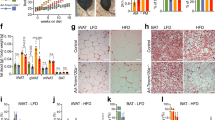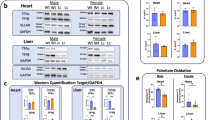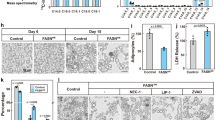Abstract
Mice carrying mutations in the fatty liver dystrophy (fld) gene have features of human lipodystrophy1, a genetically heterogeneous group of disorders characterized by loss of body fat, fatty liver, hypertriglyceridemia and insulin resistance2,3,4. Through positional cloning, we have isolated the gene responsible and characterized two independent mutant alleles, fld and fld2J. The gene (Lpin1) encodes a novel nuclear protein which we have named lipin. Consistent with the observed reduction of adipose tissue mass in fld and fld2J mice, wild-type Lpin1 mRNA is expressed at high levels in adipose tissue and is induced during differentiation of 3T3-L1 pre-adipocytes. Our results indicate that lipin is required for normal adipose tissue development, and provide a candidate gene for human lipodystrophy. Lipin defines a novel family of nuclear proteins containing at least three members in mammalian species, and homologs in distantly related organisms from human to yeast.
This is a preview of subscription content, access via your institution
Access options
Subscribe to this journal
Receive 12 print issues and online access
$209.00 per year
only $17.42 per issue
Buy this article
- Purchase on SpringerLink
- Instant access to full article PDF
Prices may be subject to local taxes which are calculated during checkout




Similar content being viewed by others
References
Reue, K., Xu, P., Wang, X.-P. & Slavin, B.G. Adipose tissue deficiency, glucose intolerance, and increased atherosclerosis result from mutation in the mouse fatty liver dystrophy ( fld ) gene. J. Lipid Res. 41, 1067–1076 (2000).
Seip, M. & Trygstad, O. Generalized lipodystrophy, congenital and acquired (lipoatrophy). Acta Paediatr. Scand. Suppl. 413, 2–28 (1996).
Senior, B. & Gellis, S.S. The syndrome of total lipodystrophy and partial lipodystrophy. Pediatrics 33, 593–612 (1964).
Dörfler, H., Rauh, G. & Bassermann, P. Lipoatrophic diabetes. Clin. Invest. 71, 264–269 (1993).
Langner, C.A. et al. The fatty liver dystrophy ( fld ) mutation. A new mutant mouse with a developmental anormality in triglyceride metabolism and associated tissue-specific defects in lipoprotein lipase and hepatic lipase activities . J. Biol. Chem. 264, 7994– 8003 (1989).
Langner, C.A., Birkenmeier, E.H., Roth, K.A., Bronson, R.T. & Gordon, J.I. Characterization of the peripheral neuropathy in neonatal and adult mice that are homozygous for the fatty liver dystrophy ( fld ) mutation. J. Biol. Chem. 266 , 11955–11964 (1991).
Rehnmark, S., Giometti, C.S., Slavin, B.G., Doolittle, M.H. & Reue, K. The fatty liver dystrophy mouse: microvesicular steatosis associated with reduced fatty acid oxidation and altered expression levels of peroxisome proliferator-regulated proteins. J. Lipid Res. 39, 2209–2217 ( 1998).
Klingenspor, M., Xu, P., Cohen, R.D., Welch, C. & Reue, K. Altered gene expression pattern in the fatty liver dystrophy mouse reveals impaired insulin-mediated cytoskeleton dynamics. J. Biol. Chem. 274, 23078–23084 ( 1999).
Shimomura, I. et al. Insulin resistance and diabetes mellitus in transgenic mice expressing nuclear SREBP-1c in adipose tissue: model for congenital generalized lipodystrophy. Genes Dev. 12, 3182– 3194 (1998).
Shimomura, I., Hammer, R.E., Ikemoto, S., Brown, M.S. & Goldstein, J.L. Leptin reverses insulin resistance and diabetes mellitus in mice with congenital lipodystrophy. Science 401, 73–76 ( 1999).
Hegele, R.A., Cao, H., Huff, M.W. & Anderson, C.M. LMNA R482Q mutation in partial lipodystrophy associated with reduced plasma leptin concentration . J. Clin. Endocrinol. Metab. 85, 3089– 3893 (2000).
Péterfy, M., Phan, J., Oswell, G.M., Xu, P. & Reue, K. Genetic, physical and transcript map of the fld region on mouse chromosome 12. Genomics 62, 436–444 (1999).
Okano, H., Aruga, J., Nakagawa, T., Shiota, C. & Mikoshiba, K. Myelin basic protein gene and the function of antisense RNA in its repression in myelin-deficient mutant mouse. J. Neurochem. 56, 560–567 ( 1991).
Ailhaud, G., Grimaldi, P. & Negrel, R. Cellular and molecular aspects of adipose tissue development . Annu. Rev. Nutr. 12, 207– 233 (1992).
Cao, H. & Hegele, R.A. Nuclear lamin A/C R482Q mutation in Canadian kindreds with Dunnigan-type familial partial lipodystrophy. Hum. Mol. Genet. 9, 109–112 (2000).
Shackleton, S. et al. LMNA, encoding lamin A/C, is mutated in partial lipodystrophy . Nature Genet. 24, 153– 156 (2000).
Comuzzie, A.G. et al. A major quantitative trait locus determining serum leptin levels and fat mass is located on human chromosome 2. Nature Genet. 15, 273–275 ( 1997).
Rotimi, C.N. et al. The quantitative trait locus on chromosome 2 for serum leptin levels is confirmed in African-Americans. Diabetes 48, 643–644 (1999).
Hager, J. et al. A genome-wide scan for human obesity genes reveals a major susceptibility locus on chromosome 10. Nature Genet. 20, 304–308 (1998).
Spiegelman, B.M., Frank, M. & Green, H. Molecular cloning of mRNA from 3T3 adipocytes. Regulation of mRNA content for glycerophosphate dehydrogenase and other differentiation-dependent proteins during adipocyte development. J. Biol. Chem. 258, 10083–10089 (1983).
Student, A.K., Hsu, R.Y. & Lane, M.D. Induction of fatty acid synthetase synthesis in differentiating 3T3-L1 preadipocytes. J. Biol. Chem. 255, 4745–4750 (1980).
McCarthy, L.C. et al. A first-generation whole genome-radiation hybrid map spanning the mouse genome. Genome Res. 7, 1153– 1161 (1997).
Thompson, J.D., Higgins, D.G. & Gibson, T.J. CLUSTALW: improving the sensitivity of progressive multiple sequence alignment through sequence weighting, position-specific gap penalties and weight matrix choice. Nucleic Acids Res. 22, 4673–4680 (1994).
Perriere, G. & Gouy, M. WWW-query: an on-line retrieval system for biological sequence banks. Biochimie 78, 364– 369 (1996).
Rowe, L.B., Sweet, H.O., Gordon, J.I. & Birkenmeier, E.H. The fld mutation maps near to but distinct from the Apob locus on mouse Chromosome 12. Mamm. Genome 7, 555–557 (1996).
Deloukas, P. et al. A physical map of 30,000 human genes. Science 282, 744–746 (1998).
Acknowledgements
We thank L. Rowe and the late E. Birkenmeier for a set of (BALB/c-fld×CAST)F2 DNA samples; T. Beischlag for the Arnt-GFP construct; B. Slavin for adipose tissue sections; Q. Han for assistance in the cell culture; and D. Scott for assistance with fluorescence microscopy. This work was supported by grant HL24841 from the National Institutes of Health.
Author information
Authors and Affiliations
Corresponding author
Supplementary information
Figure A
Alignments of the NLIP and CLIP domains showing positions of residues that are identical (black background) or similar (gray background) in at least 90% of the sequences. The asterisk above the NLIP sequence denotes the position of the Gly84Arg mutation in fld2J mice. (PPT 392 kb)
Rights and permissions
About this article
Cite this article
Péterfy, M., Phan, J., Xu, P. et al. Lipodystrophy in the fld mouse results from mutation of a new gene encoding a nuclear protein, lipin. Nat Genet 27, 121–124 (2001). https://doi.org/10.1038/83685
Received:
Accepted:
Issue Date:
DOI: https://doi.org/10.1038/83685



